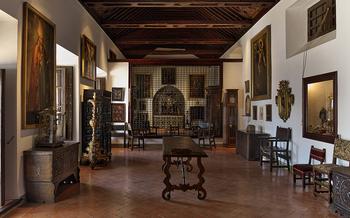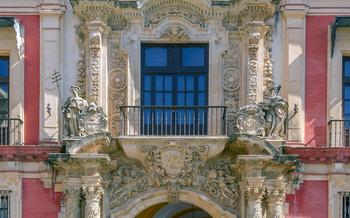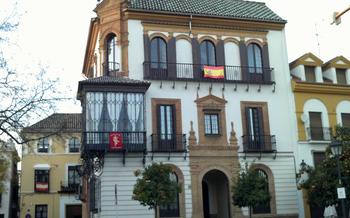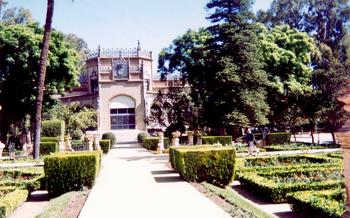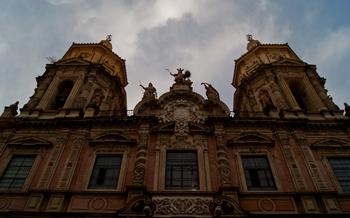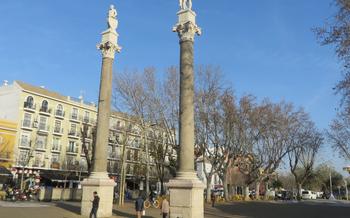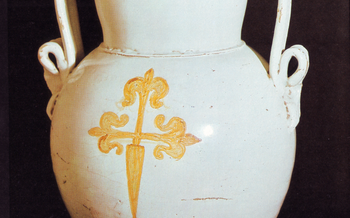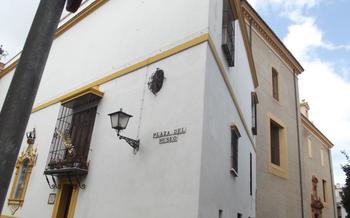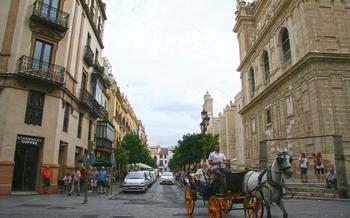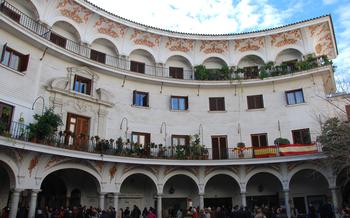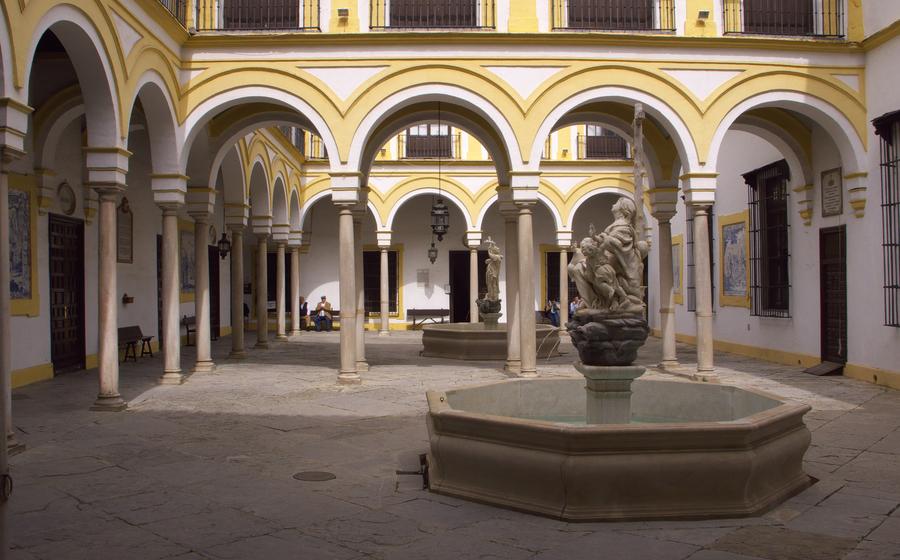
Hospital de la Caridad
- Historical Background
- Location and Accessibility
- Admission and Hours of Operation:
- Artwork and Exhibits
- Baroque Architecture
- Chapel of San Jorge
- Hospital Museum
- The Brotherhood of Charity
- Historical Significance
- Guided Tours
- Photography and Social Media
- Souvenirs and Gifts
- Accessibility:
- Insider Tip:
Historical Background
Founded in 1674 by Justino de Neve, a wealthy merchant, the Hospital de la Caridad stands as a testament to Seville's rich philanthropic tradition. Initially established as a charitable institution dedicated to providing care for the sick and needy, the hospital embodied the spirit of compassion and social welfare that prevailed in the city during the 17th century. Its architectural grandeur, a masterpiece of Baroque design, reflects the opulence and artistic patronage that characterized Seville's Golden Age. In the 20th century, the hospital underwent a transformation, evolving into a museum that showcases its artistic and cultural legacy, preserving its historical significance while offering visitors a glimpse into Seville's vibrant past.
Location and Accessibility
The Hospital de la Caridad is conveniently situated in the heart of Seville's historic center, at Calle Temprado, To get there, visitors can take advantage of the city's efficient public transportation system. The C5 bus line stops right outside the hospital, and the nearby Puerta de Jerez metro station on Line 1 provides easy access.
The hospital's central location places it within walking distance of many other notable landmarks and attractions. The majestic Seville Cathedral, with its awe-inspiring Giralda Tower, is just a short stroll away. Visitors can also explore the vibrant Triana neighborhood, known for its colorful ceramics and lively flamenco performances, located just across the Guadalquivir River.
The Hospital de la Caridad is committed to accessibility for all visitors. Wheelchair ramps and elevators ensure that all areas of the museum are accessible to those with mobility challenges. Accessible restrooms are also available on-site. For visitors with specific accessibility needs, it is advisable to contact the museum in advance to arrange for assistance.
Admission and Hours of Operation:
Admission to the Hospital de la Caridad is currently set at a modest fee, with discounts available for students, seniors, and groups. Be sure to check the official website or contact the museum directly to confirm the latest admission rates and any special offers.
The museum's hours of operation vary depending on the season. During the peak tourist season, from April to September, it is generally open from 10:00 am to 8:00 pm, with extended hours on weekends. In the off-season, from October to March, the museum typically operates from 10:00 am to 6:00 pm, with shorter hours on weekends.
It is advisable to plan your visit accordingly, taking into account the museum's operating hours and any potential seasonal variations. To avoid disappointment, it is always a good idea to check the official website or contact the museum directly for the most up-to-date information on admission fees and hours.
The Hospital de la Caridad also offers guided tours, which provide a deeper insight into the history, art, and architecture of the institution. These tours are available in various languages and can be booked in advance or upon arrival, subject to availability.
Artwork and Exhibits
The Hospital de la Caridad houses an impressive collection of artwork that reflects the artistic and cultural heritage of Seville. Visitors can admire notable pieces by renowned artists such as Bartolomé Esteban Murillo and Juan de Valdés Leal, two of the most influential painters of the Spanish Baroque period. Murillo's works, known for their soft and luminous colors, depict religious scenes and everyday life with a profound emotional depth. Valdés Leal, on the other hand, is famous for his stark and dramatic paintings, often featuring skeletal figures and macabre imagery.
The paintings and sculptures on display at the Hospital de la Caridad explore various themes and symbols related to charity, mortality, and redemption. Visitors can contemplate the power of compassion in Murillo's "The Miracle of St. Anthony of Padua" or reflect on the transience of life in Valdés Leal's "In Ictu Oculi" (In the Blink of an Eye), a series of paintings depicting the decomposition of human bodies.
In addition to the permanent collection, the Hospital de la Caridad also hosts temporary exhibitions and rotating displays. These exhibitions showcase a diverse range of artwork, from contemporary interpretations of traditional themes to works by emerging artists. Visitors are encouraged to check the museum's website or contact the museum directly for information about current and upcoming exhibitions.
Baroque Architecture
The Hospital de la Caridad stands as a testament to the grandeur of Baroque architecture, characterized by its intricate details, dramatic lighting, and an interplay of curves and movement. Its facade is a masterpiece of Baroque design, adorned with sculptures, decorative elements, and a grand entrance that invites visitors into the hospital's opulent interior.
Inside, the hospital's architecture continues to impress with its soaring ceilings, elaborate arches, and stunning frescoes. The use of natural light, through strategically placed windows and skylights, creates a sense of drama and enhances the impact of the artwork displayed throughout the building.
The architects and artisans who worked on the Hospital de la Caridad, including Bartolomé Esteban Murillo and Juan de Valdés Leal, skillfully blended the principles of Baroque architecture with the institution's charitable mission. The result is a harmonious and awe-inspiring space that reflects the hospital's dedication to providing care and comfort to those in need.
Chapel of San Jorge
Within the sacred walls of the Hospital de la Caridad, a hidden gem awaits discovery—the Chapel of San Jorge. This exquisite sanctuary, dedicated to the patron saint of Seville, is a masterpiece of Baroque artistry, showcasing an intricate altarpiece adorned with sculptures and paintings that narrate biblical tales with vivid detail. The altarpiece, a testament to the skill and devotion of its creators, serves as a focal point for worship and contemplation, inviting visitors to immerse themselves in its sacred beauty.
The Chapel of San Jorge is not merely an architectural marvel but also a place of profound spiritual significance. Throughout the centuries, it has served as a sanctuary for the sick and suffering, offering solace and comfort to those in need. Special religious services and events, such as masses and processions, are held within the chapel, further enhancing its spiritual atmosphere and fostering a sense of community among the faithful.
Hospital Museum
The Hospital de la Caridad has undergone a remarkable transformation into a museum, preserving and showcasing its rich history and artistic heritage. The museum exhibits offer a glimpse into the hospital's past, its charitable mission, and the impressive collection of artwork that graces its walls. Visitors can explore the various galleries and displays, each telling a unique story about the hospital's journey through time. Interactive elements and educational programs further enhance the museum experience, providing visitors with a deeper understanding of the hospital's significance. Take your time wandering through the museum, absorbing the stories and marveling at the beauty that surrounds you. Discover the legacy of the Hospital de la Caridad and its enduring impact on the cultural and social fabric of Seville.
The Brotherhood of Charity
The Hospital de la Caridad was founded and operated by the Brotherhood of Charity, a charitable organization dedicated to caring for the sick and needy in Seville. Founded in 1578, the Brotherhood played a crucial role in the establishment and maintenance of the hospital. Its members, driven by compassion and a deep sense of social responsibility, devoted their time and resources to providing medical care, food, and shelter to those in need. The Brotherhood's unwavering commitment to charitable work reflected the values and philanthropic spirit that prevailed in Seville during the 17th and 18th centuries. Their legacy continues today through the Hospital Museum, which serves as a testament to their dedication and the enduring power of compassion.
Historical Significance
The Hospital de la Caridad holds immense historical significance as a social welfare institution, reflecting the evolving attitudes towards healthcare and philanthropy in Seville during the 17th and 18th centuries. It embodied the spirit of compassion and care for the sick and needy, becoming a beacon of hope for those suffering from illness or poverty. The hospital's establishment marked a shift towards a more organized and systematic approach to healthcare, paving the way for the development of modern medical practices and social services in the city. Its legacy as a charitable institution continues to inspire and shape the social welfare landscape of Seville to this day, showcasing the enduring impact of the Brotherhood of Charity's vision and dedication. Visitors to the Hospital de la Caridad are encouraged to appreciate its role in shaping Seville's history and the profound influence it has had on the city's social and cultural fabric.
Guided Tours
Booking a guided tour is highly recommended to enhance your visit to the Hospital de la Caridad and gain deeper insights into its history and significance. Knowledgeable guides will provide context and explanations, bringing the hospital's story to life. Different tour options are available, including general tours that cover the highlights, themed tours focusing on specific aspects, and private tours tailored to your interests. Inquire about tour schedules and availability when planning your visit. Embark on a guided journey to unravel the rich heritage of this remarkable institution.
Photography and Social Media
Capture the beauty of the Hospital de la Caridad through the lens of your camera and share your experiences with the world on social media. Photography is permitted within the museum, so don't hesitate to snap away and document your visit. Remember to tag the museum's official social media accounts, such as @hospitaldelacaridadseville, for a chance to be featured and connect with other travelers who share your passion for art and history. Use relevant hashtags like #hospitaldelacaridad, #seville, and #baroquearchitecture to join the conversation and inspire others to explore this hidden gem.
Souvenirs and Gifts
As you explore the Hospital de la Caridad, take the opportunity to visit the gift shop and browse the unique selection of souvenirs and gifts available. Here, you can find a variety of items inspired by the hospital's history, artwork, and mission. Purchase a postcard to send to loved ones, or select a book about the hospital's rich heritage. For those who appreciate art, consider buying a replica of a painting or sculpture from the museum's collection. Your purchase not only serves as a memento of your visit but also helps support the museum's ongoing efforts to preserve and showcase its treasures.
Accessibility:
The Hospital de la Caridad is committed to providing an inclusive and welcoming environment for all visitors, regardless of their abilities. Wheelchair ramps, elevators, and accessible restrooms are available throughout the museum, ensuring that everyone can comfortably explore the exhibits and admire the artwork. Visitors with specific accessibility needs are encouraged to contact the museum in advance so that arrangements can be made to accommodate their needs. The staff is dedicated to creating a positive and memorable experience for all, fostering an atmosphere of respect and understanding among visitors.
Insider Tip:
For an unforgettable experience, visit the Hospital de la Caridad during the annual Seville Fair, when the city comes alive with vibrant colors, music, and festivities. Immerse yourself in the lively atmosphere as you wander through the hospital's courtyards, adorned with colorful decorations and buzzing with energy. Take advantage of the extended hours during the fair to explore the museum's collection and admire the stunning artwork under the soft glow of evening lights. This unique opportunity offers a magical glimpse into Seville's rich history and culture, creating lasting memories of your visit to the Hospital de la Caridad.
